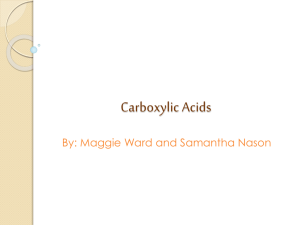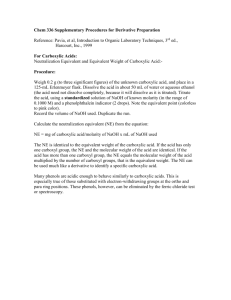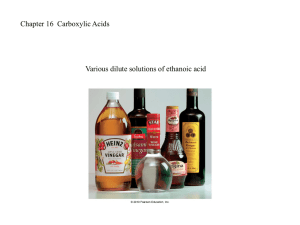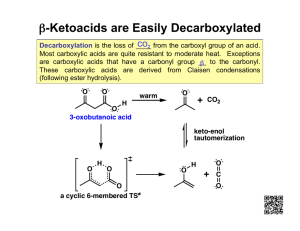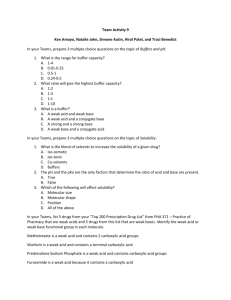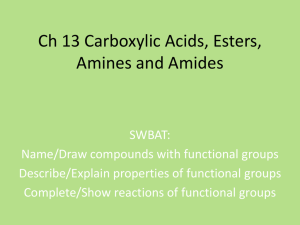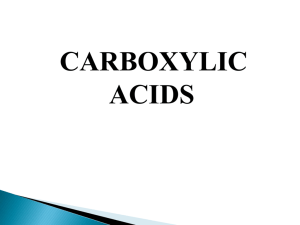Carboxylic Acids
advertisement
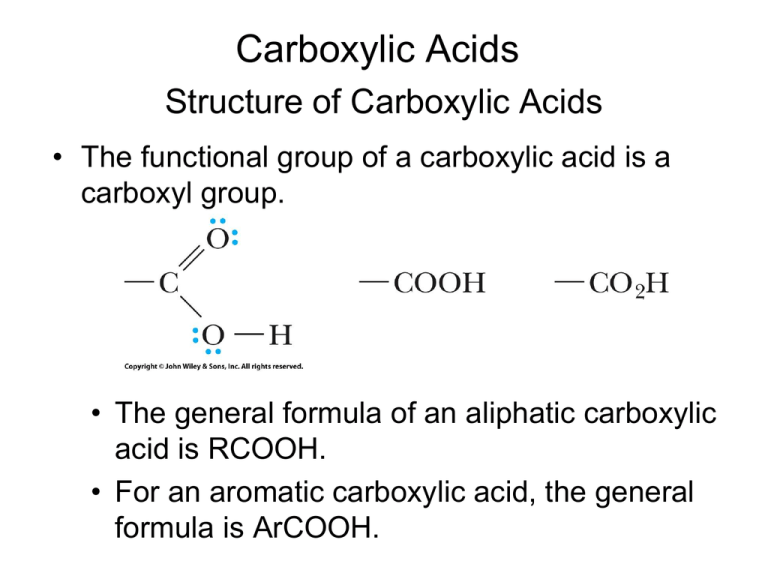
Carboxylic Acids Structure of Carboxylic Acids • The functional group of a carboxylic acid is a carboxyl group. • The general formula of an aliphatic carboxylic acid is RCOOH. • For an aromatic carboxylic acid, the general formula is ArCOOH. Nomenclature of Carboxylic Acids • IUPAC names: drop the -e from the parent alkane and add the suffix -oic acid. – If the compound contains a carbon-carbon double bond, change the infix -an- to -en-. • The carboxyl group takes precedence over most other functional groups. • If the carboxyl group is bonded to a ring, name the ring compound and add the suffix carboxylic acid. • Dicarboxylic acids: add -dioic acid to the name of the parent alkane. • There is no need to use numbers to locate the carboxyl groups; they can only be on the ends of the chain. • Benzoic acid is the simplest aromatic carboxylic acid. • Use numbers to show the location of substituents. • Know the common names of formic and acetic acid. formic acid acetic acid • In common nomenclature, keto indicates the presence of a ketone, and CH3CO– is named an aceto group. • When common names are used, the letters , , , , , etc… are often used to locate substituents. Physical Properties of Carboxylic Acids • In the liquid and solid states, carboxylic acids are associated by hydrogen bonding into dimeric structures. • Carboxylic acids have significantly higher boiling points than other types of organic compounds of comparable molecular weight. • They are polar compounds and form very strong intermolecular hydrogen bonds. • Carboxylic acids are more soluble in water than are alcohols, ethers, aldehydes, and ketones of comparable molecular weight. • They form hydrogen bonds with water molecules through their C=O and OH groups. • Water solubility decreases as the relative size of the hydrophobic portion of the molecule increases. Acidity of Carboxylic Acids • Carboxylic acids are stronger weak acids • Values of pKa for most aliphatic and aromatic carboxylic acids fall within the range 4 to 5. • The greater acidity of carboxylic acids relative to alcohols, both of which contain an OH group, is due to resonance stabilization of the carboxylate anion. • Electron-withdrawing substituents near the carboxyl group increase acidity through their inductive effect. • The acid-strengthening effect of a halogen substituent falls off rapidly with increasing distance from the carboxyl group. Summary of Reactions • • • • • Reactions with bases Reduction Esterification (Fischer) Conversion to acid chloride (via SOCl2) Decarboxylation Reaction with Bases • Carboxylic acids, whether soluble or insoluble in water, react with NaOH, KOH, and other strong bases to give water-soluble salts. • They also form water-soluble salts with ammonia and amines. • Carboxylic acids react with sodium bicarbonate and sodium carbonate to form water-soluble salts and carbonic acid. • Carbonic acid, in turn, breaks down to carbon dioxide gas (bubbles) and water. • Only a stronger weak acid (pKa < 7) will react with bicarbonate (carbonate); therefore, bubbling is confirmation of the presence of a carboxylic acid. Reduction • The carboxyl group is very resistant to reduction. • • • It is not affected by catalytic hydrogenation under conditions that easily reduce aldehydes and ketones and reduce alkenes and alkynes. Carboxyl groups are not reduced by NaBH4. Lithium aluminum hydride reduces a carboxyl group to a 1° alcohol. • Reduction is carried out in diethyl ether, THF, or other nonreactive, aprotic solvents. • we can use NaBH4 to reduce an aldehyde or ketone in the presence of a COOH group. • Catalytic hydrogenation does not reduce a COOH group. • we can use H2/M to reduce an alkene in the presence of a COOH group. (Fischer) Esterification • Esters can be prepared by treating a carboxylic acid with an alcohol in the presence of an acid catalyst, commonly H2SO4 or gaseous HCl. • Fischer esterification is an equilibrium reaction. • By careful control of experimental conditions, it is possible to prepare esters in high yield. • If the alcohol is inexpensive relative to the carboxylic acid, it can be used in excess to drive the equilibrium to the right (toward ester production). • A key intermediate in Fischer esterification is a tetrahedral carbonyl addition intermediate (TCAI) formed by addition of ROH to the C=O group. H O R C OH + HOCH3 + H O R C OCH3 O H TCAI + H O R C OCH3 + HOH Acid Chlorides • The functional group of an acid halide is a carbonyl group bonded to a halogen atom. • Among the acid halides, acid chlorides are by far the most common and the most widely used. • In older nomenclature, these compounds were known as acyl halides. • Acid chlorides are most often prepared by treating a carboxylic acid with thionyl chloride. • Acid chlorides do not have many applications; however, they are very reactive; therefore they are extremely useful in the synthesis of molecules. (More next chapter) Decarboxylation • Decarboxylation: loss of CO2 from a carboxyl group. • Most carboxylic acids, if heated to a very high temperature, undergo thermal decarboxylation. • However, at lower temperatures, most are quite resistant to decarboxylation. • Exceptions are carboxylic acids that have a carbonyl group beta to the carboxyl group. • -ketoacids undergo decarboxylation on mild heating. • Thermal decarboxylation of a -ketoacid involves rearrangement of six electrons in a cyclic sixmembered transition state. (FYI only)
